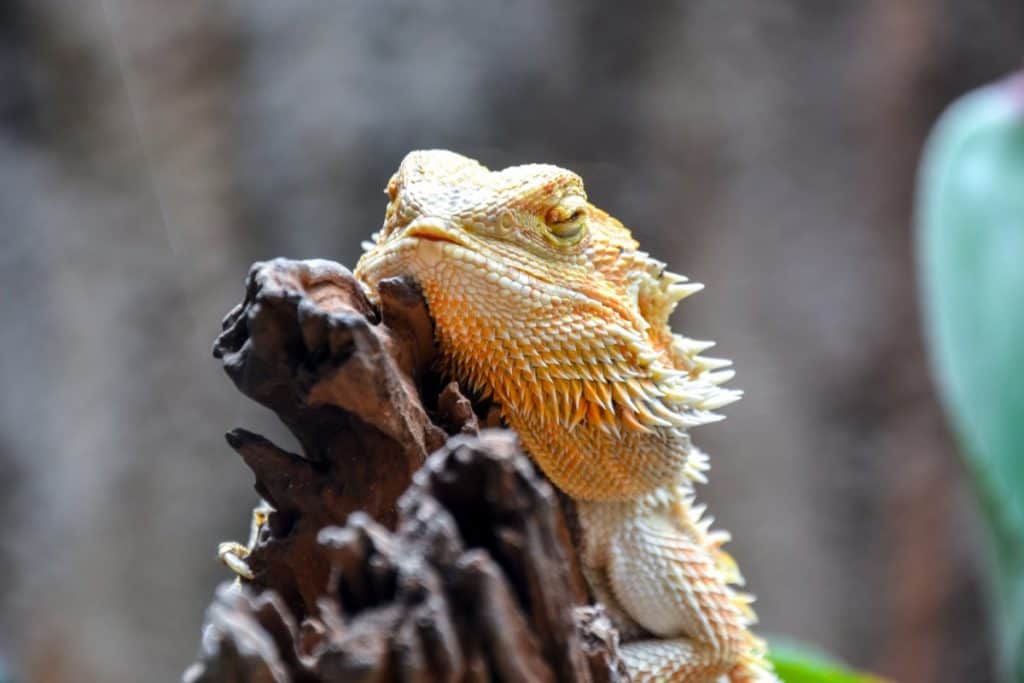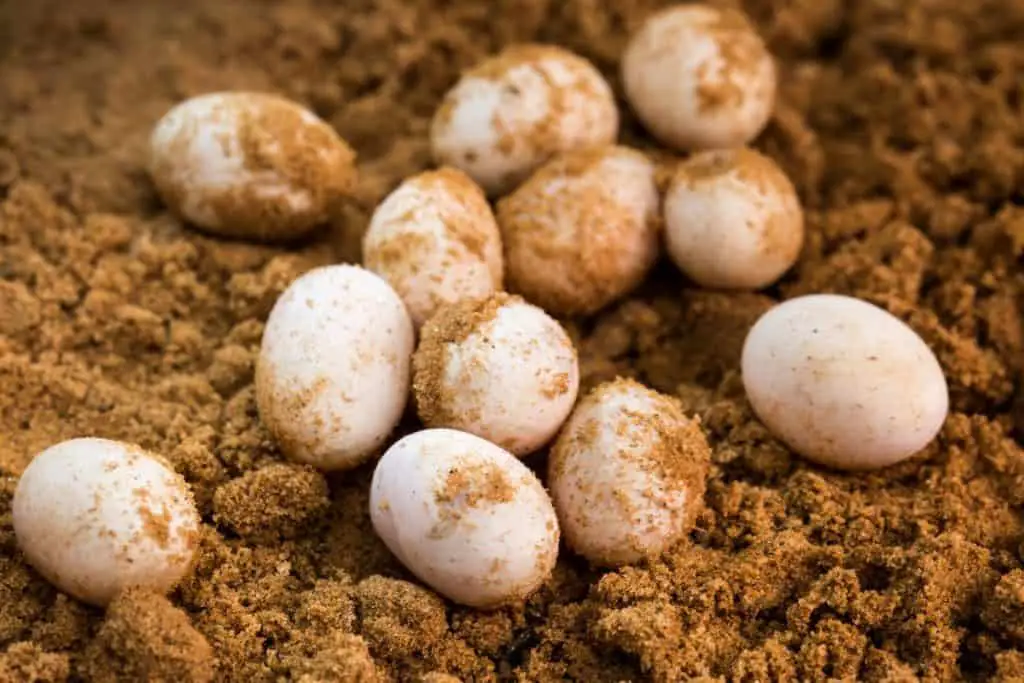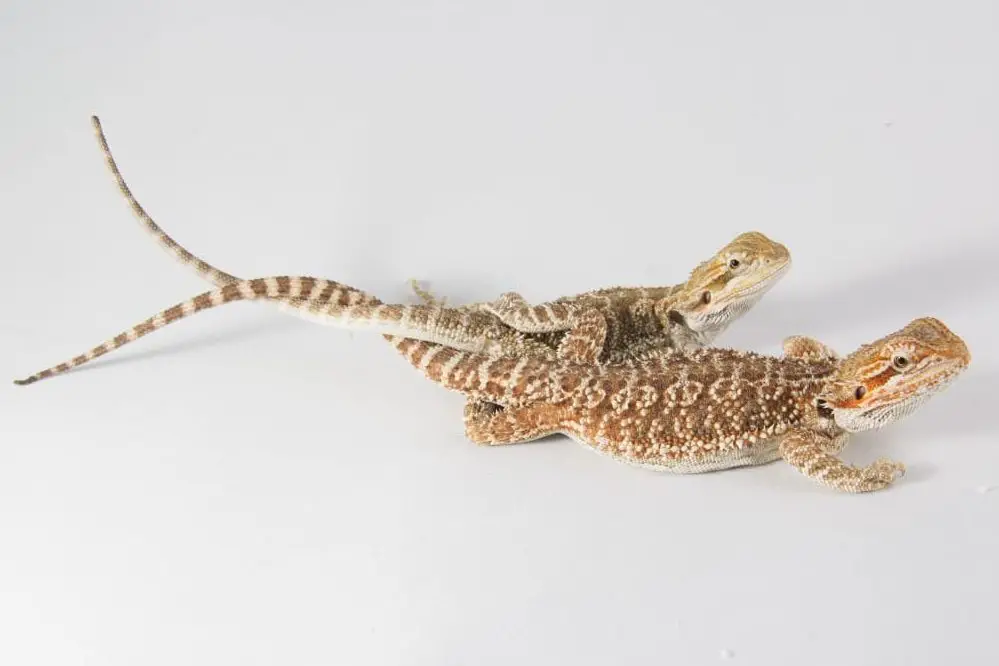Affiliate Disclosure: This post may contain affiliate links. If you make a purchase after clicking on these links I will be compensated at no extra cost to you. However, I never recommend anything I don’t love or wouldn’t use myself!
Having learned a lot about bearded dragons and their mating rituals recently, I decided to put together this guide. If you are interested in mating your bearded dragons or even if you are just fascinated by bearded dragons in general, you’re in the right place.
This article covers everything from how to prepare your bearded dragons for breeding, right the way through to incubating and hatching their eggs along with many of the risks involved.
How to Prepare for Bearded Dragon Breeding
Bearded dragons in captivity can be bred at any time of the year, however, ensuring successful breeding takes a lot of time and preparation. It is important to learn about the process of bearded dragon breeding, before beginning the process.
First of all, it’s fairly crucial to establish the sex of your bearded dragons…
Determining the Sex of Bearded Dragons:
Here are some physical characteristics which will enable you to tell a male and female bearded dragon apart:
- A male bearded dragon has a larger head than a female bearded dragon. However, at times, a female’s head could be larger or about the same size, so it is not always the best way to tell them apart. Also, if you only have one bearded dragon this is not the best way to tell which sex you have.
- In the abdominal region, a male’s girth will usually be smaller than that of a female’s and he will have larger pores in the anal region. However, as with the previous method, this is not always the best method of determining a bearded dragon’s sex as there are exceptions and you need another dragon to compare.
- The best way to determine a bearded dragon’s sex is by looking at its hemipenile bulges. In order to check this region, you will need to hold the dragon in the palm of your hand on its back and very carefully bend its tail toward its back at a 90-degree angle.
This must be done carefully to not cause damage to its spine. If there are two bulges on either side of the tail, then that bearded dragon is a male. If there is only one centered bulge or no bulges at all then the dragon is a female.
Health Checks in Preparation for Mating Bearded Dragons:
In preparation for mating your bearded dragons, you need to take them to the vet so they can perform an extensive physical to ensure they are in optimal health. Bearded dragons must be in the best possible health prior to mating to reduce the risk of health issues in both the parents and the offspring.
Your vet will also check for atadenovirus (adenovirus), which can be highly contagious among bearded dragons. Furthermore, this can be passed on to their young.
Here are a couple of key things that you should consider before taking them:
- It’s important that your bearded dragon is not shedding at the time of testing for adenovirus. This can potentially lead to a false-negative test. Your dragons should be tested regularly prior to mating to ensure that they don’t have the virus.
- Your vet should check your bearded dragons’ weight, length, and age before you start breeding them. The male should be at least 18 months old and the female dragon should be at least 24 months old. For the best results when breeding, both dragons should be at least 18 inches in length and the female should weigh at least 350 grams.
Brumation in Preparation for Mating Bearded Dragons:

Brumation is crucial before both male and female bearded dragons are to begin mating. Brumation is basically the cold-blooded equivalent of hibernation.
In the wild, this would naturally happen around winter time when temperatures begin to drop and food is more scarce and should last for around 3 months. Bearded dragons go into a state of low activity to conserve energy for when mating season arrives in springtime.
- In captivity, brumation can be achieved by decreasing their lighting schedule so that their lighting only comes on for around 8 hours per day. This is to occur while they are still in separate caging.
- While decreasing their lighting schedule, you also need to decrease the temperature to around 80 degrees Fahrenheit and just 60 degrees Fahrenheit during the night or dark hours. During this time, bearded dragons will become less active, eat less, hide more often, and spend noticeably less time basking.
- After the brumation period is over, you can start to increase their lighting schedule again and they should resume activity and eating as normal. When preparing the bearded dragons for mating, brumation needs to take place at least 2 or 3 months before they are to be bred for best results.
Supplement Your Bearded Dragon’s Diet Prior to Mating:
You will need to make sure that your female bearded dragon has supplements that contain calcium and vitamin D3. This is to ensure that her eggs are sufficiently calcified once she lays them and that she will not suffer a calcium deficiency after she lays her eggs. To promote optimal health, multivitamins are recommended for both sexes as well.
- Veterinarians recommend this type of supplementation in the weeks before breeding bearded dragons. Any questions on how to do so should be shared with the veterinarian you are taking your bearded dragons to.
Prepare a Breeding Habitat for Bearded Dragons:
Typically, your male and female bearded dragons won’t be living together, however, it is important that you provide the right type of environment for them when they are ready to mate.
Make sure that the enclosure is large enough for both of your dragons. You should really aim for 125 gallons or more but at the very least, you should have an enclosure size of 75 gallons.
Some people make their own enclosures for this purpose. As floor space can vary, you are probably best off to go to your local pet store and seek help to determine what size enclosure is best suited for your needs.
- Glass aquariums are the most popular choice by far as enclosures for bearded dragons. However, other types are available such as melamine cages and PVC cages. If you decide to invest in a screen lid for your enclosure cover, it will help circulate fresh air while still keeping your dragons from escaping.
- Be sure to use a thermometer to monitor and assist in maintaining the overall temperature. It needs to be at 77 to 88 degrees Fahrenheit during the day and within the mid-’70s at night.
- You’ll need a basking light in the enclosure to provide a focal point for basking at a temperature of 105 degrees Fahrenheit.
- Place full spectrum light bulbs that give off UVA and UVB rays above the enclosure where the bearded dragons will spend most of their time. The UVA and UVB rays from the lightbulbs will assist the bearded dragons in vitamin D production that is also vital for mating.
- Terraform the enclosure: This means placing rocks, leaves, and branches inside of the enclosure to give the bearded dragons objects to climb on. They’ll also need to hide from each other and rest due to the aggressive nature of mating.
Preparing a Nesting Habitat for Bearded Dragons:
Once your male and female bearded dragons have mated, and the female is pregnant (gravid), you will need to move her to a location to lay her eggs. The nesting habitat or lay box is where this is done.
- The ideal nesting box should be an 8 to 10-gallon plastic container with a secured lid that will allow for the circulation of fresh air. The box should be filled with 8 inches of potting soil or topsoil along with sand.
- The sand and soil mixture needs to be damp enough that it lightly clumps together and it is not difficult for your female bearded dragon to dig into. If the soil is too dry, it will cave in when she goes into trying to bury her eggs. It also shouldn’t be so wet that water trickles out when you squeeze the soil in your hands.
Purchase an Incubator for the Bearded Dragon Eggs:
You will have to invest in an incubator for the eggs once the female bearded dragon lays them. They will have to be removed from the nesting habitat and relocated to the incubator. For this, it is best to purchase an incubator from the pet store as opposed to building one yourself to prevent malfunctions.
- You are going to have to fill small containers with vermiculite or perlite, which is available at most local gardening stores to place within the incubator. Make impressions in the substrate so you can nestle the eggs into them later on. Cover the containers with lids that allow for fresh air circulation.
How Do Bearded Dragons Mate?
With most of the preparation out of the way, you should finally be ready to place your bearded dragons together in their breeding habitat. So what should you expect during the mating process itself?
The Mating Process for Bearded Dragons:
Even though most of the time bearded dragons are very docile and peaceful, when it comes to mating it tends to be a different story entirely, particularly when it comes to the males. These are some extremely aggressive creatures when it comes to the act of reproducing.
When preparing to mate, bearded dragons will usually perform a mating “dance” before mating. Here are a few things to expect:
- The male bearded dragon’s “beard” will start to become darker and this can last a few days.
- The bearded dragons will begin to run around each other and making rolling and bobbing motions with their heads.
- The female bearded dragon may wave an arm as an indication that she is willing to mate with the male bearded dragon.
- The male bearded dragon may stomp his feet and chase the female within the enclosure.
- When the male is ready, he will bite on the neck of the female dragon to keep her from running away.
- The male will then swing his bag leg and place it on the female and curl his tail around her tail.
- The female will stand in position for the male dragon to insert his hemipenis. This will continue for a few minutes and then the female will eventually push back at the male so he will let go of her. This will potentially be followed by a head roll and head bob.
Post Mating Care for Bearded Dragons:
As mentioned previously, the mating process for bearded dragons can be extremely rough. Here are some guidelines on how to care for both the male and female dragons after mating:
- Male bearded dragons bite to hold the female in place and can leave some wounds on the female dragon’s neck and lips. To prevent possible infection, be sure to flush the wounds with salt-water and apply antibiotic ointment to the wound sites. Finally, cover the affected areas with a pad.
- After a male bearded dragon mates with a female, his hemipenes will be exposed for a short while before retracting. If it remains exposed and has not retreated, you should try to keep it moist with warm water and take him to the vet as soon as possible
Experts recommend that you should keep the male and female bearded dragons together for one week after mating before separating them for a week so they can get some respite from one another. Once they have been separated for one week the process can be repeated several times to ensure that successful mating has occurred.
It is important to continue feeding your female bearded dragon supplements after mating. Keeping her more active and well-hydrated will ensure she is better prepared to begin laying her eggs when ready.
Bearded Dragon Egg Laying Guidelines

Eventually, after all of your work in helping your bearded dragons mate, your female bearded dragon will be ready to lay her eggs about 6 to 8 weeks later.
To know when this time is, you will need to keep an eye on her when she is alone in her cage. There are certain signs that you should watch for that show her different levels of readiness to lay eggs.
- The beginning of the nesting behavior starts about three weeks into pregnancy. The female will start to dig into her enclosure, indicating that she needs a proper nesting area.
- When the female is getting very close to laying her eggs, she will become less active than usual, spending more time laying under the heating lamp. She will also begin to eat less.
- One of the easiest ways to tell that she is ready to lay her eggs is by inspecting her belly. The eggs should be easily noticeable and will look like and feel like marbles in her belly. This means they are ready to be laid any day.
When she begins showing these signs, it is time to relocate her to the nesting habitat that you had created for her prior. You will need to be very gently and move her from her enclosure to the lay box.
When you place the female in the nesting habitat, it is important to remove her after the eggs are laid. Bearded dragons may be great pets but they aren’t the most maternal of creatures and they can often damage or even eat their own eggs.
- Bearded dragons tend to lay their eggs in the afternoon or early evening. If possible, try to watch her during these times to see if she looks like she is ready to begin laying her eggs.
- Female bearded dragons lay around 24 eggs at a time on average. They may lay as few as 15 eggs or potentially lay as many as 50 at one time. This group of eggs is called a clutch.
Egg Binding in Bearded Dragons
Sometimes, after your bearded dragon has held her eggs for more than 45 days, there is a chance she may become egg bound meaning she is unable to lay her eggs. Often this is a result of her having low calcium levels and so the eggshells have not formed properly.
Being ‘egg-bound’ is a serious condition that can be fatal for the mother. If you do not believe that your female bearded dragon has laid all of her eggs, you must take her to the vet as soon as possible.
Bearded dragons that are suffering from egg binding will become very lethargic and inactive. You should be able to tell that she is not feeling well.
If you suspect this is the case for your bearded dragon, it is extremely important to see a veterinarian as soon as possible in order to remove the eggs. If the eggs are already in the oviduct, your vet may be able to try an oxytocin shot.
Incubating and Hatching Bearded Dragon Eggs
Properly caring for the eggs of any animal is not the simplest of tasks. You must follow all guidelines up to this point and after to ensure that your bearded dragon didn’t go through the ordeal of mating for no reason.
After the female dragon lays the eggs, you must very carefully remove them from the nesting habitat and place them into the incubator. It’s important to make sure they remain in the same orientation as when they were laid. You can mark them with a soft marker to help you maintain their orientation.
Be sure to place each egg individually into the vermiculite or perlite, use one of the depressions that you created earlier. The egg should not be covered completely, but comfortably nested so that it doesn’t roll around. Finally, place the lid on the container.
It is important to make sure the temperature of the incubator is maintained at a temperature between 82° F and 86° F. If the temperature gets too high in the incubator, you will risk the embryos dying inside of the eggs so be sure to track the temperature regularly using a thermometer.
Another important factor is the temperature inside the room that the incubator is kept in. The room should be cooler than the temperature inside the incubator. If it is the same temperature or warmer, it can raise the temperature inside of the incubator and put the embryos at risk.
A couple of keynotes to keep in mind:
- The incubator’s humidity should be maintained at around 80%. Place a bowl of water inside the incubator to help increase the humidity level and refill it as needed.
- Check the incubator’s temperature two times a day and the humidity two times a week
- Remove any build-up of condensation on the lid of the incubator to prevent it from dripping onto the eggs.
It is important to monitor the eggs regularly and check for whether the eggs are looking wet or overly dry. You will have to adjust the incubator if you see any condensation on the eggs as it can be deadly to embryos. If they happen to look wet at all, you will have to take the lid off the container within the incubator for 24 hours. This should release the excess humidity and allow the vermiculite and perlite to dry out.
- If eggs begin looking like they are dimpled or are going to collapse they could possibly be too dry. You will need to use room temperature water to dampen the vermiculite while ensuring that the eggs themselves don’t get wet.
- Healthy, fertile eggs will double in size and become a chalk white. Yellow, pink, or green eggs may not be fertile.
- Eggs that have mold on them may or may not be fertile. Visit the vet if you’re unsure.
- Eggs will begin to hatch within 60-70 days. Visit https://www.wikihow.com/Breed-Bearded-Dragons for a guide on hatching and caring for baby bearded dragons.
How Often Do Bearded Dragons Mate?
Wild bearded dragons typically mate during the spring. However, the bearded dragons in captivity can mate at any time of the year given preparations are in place and the conditions are right. During the time that you are mating your bearded dragons, make sure that:
- You have set up the mating habitat.
- Your female’s diet is properly supplemented with vitamin D and calcium.
- Be sure to begin brumation 2 to 3 months before the mating process begins.
- Ensure that you create an enclosure large enough for both the male and female bearded dragons for them to mate and live together for a week. View the Preparing For Mating Bearded Dragons section for more details.
At What Age Do Bearded Dragons Mate?
Bearded dragons are mature enough to mate once they reach 18 months old. The female should be at least 24 months old. As mentioned before, you should take them to the vet to get their weights and lengths accurately measured to ensure they are healthy enough to begin mating. The veterinarian will also screen for atadenovirus. A few more things to recap on:
- The male bearded dragon and female bearded dragon should be at least 18 inches in length from the snout to the tip of the tail.
- The female bearded dragon should weigh at least 350 grams to ensure she is healthy enough for mating.
- Do not breed bearded dragons that have the atadenovirus as the virus can be spread to the babies.
- The bearded dragon who is being tested for the virus cannot be shedding at the time or you may have a false negative test. Make sure that they are tested regularly before you begin breeding them.
Thank you for taking the time to read this in-depth guide on mating bearded dragons. As you can see, there is a lot of preparation involved and the small details are everything. Because of this, there is a lot of information to be understood and instructions to follow to ensure that mating is successful. If you want more information on caring for the baby bearded dragons after they are hatched, visit https://www.wikihow.com/Breed-Bearded-Dragons.
There is also a lot of information on bearded dragons and rules to consider when breeding them on various sites including https://www.lizards101.com/breeding-bearded-dragons-101-mating-nest-site-incubation-faqs/. This provides information to a lot of frequently asked questions for setting up the mating enclosure and best practices for caring for the eggs. Good luck!

